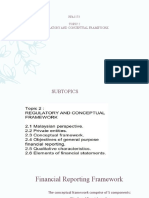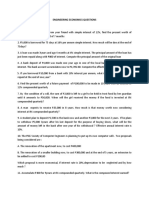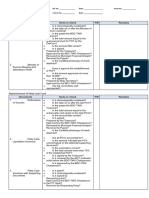0 ratings0% found this document useful (0 votes)
20 viewsACCOUNTiNG PPT For DEMO
ACCOUNTiNG PPT For DEMO
Uploaded by
JINKY TOLENTINOThis document defines key accounting and financial terms like accounting, financial statements, balance sheets, and income statements. It explains that accounting records and classifies financial transactions and events in terms of money. A financial statement shows a business's financial activities and performance through an income statement, which reports revenues, expenses and profits over time, and a balance sheet, which provides a snapshot of a business's assets, liabilities and equity at a point in time. Key elements of both statements are defined, such as the three elements that make up a balance sheet (assets, liabilities, capital) and income statement (revenues, expenses, net profit). Common types of assets and liabilities are also outlined.
Copyright:
© All Rights Reserved
Available Formats
Download as PPTX, PDF, TXT or read online from Scribd
ACCOUNTiNG PPT For DEMO
ACCOUNTiNG PPT For DEMO
Uploaded by
JINKY TOLENTINO0 ratings0% found this document useful (0 votes)
20 views15 pagesThis document defines key accounting and financial terms like accounting, financial statements, balance sheets, and income statements. It explains that accounting records and classifies financial transactions and events in terms of money. A financial statement shows a business's financial activities and performance through an income statement, which reports revenues, expenses and profits over time, and a balance sheet, which provides a snapshot of a business's assets, liabilities and equity at a point in time. Key elements of both statements are defined, such as the three elements that make up a balance sheet (assets, liabilities, capital) and income statement (revenues, expenses, net profit). Common types of assets and liabilities are also outlined.
Original Description:
accounting demo
Original Title
ACCOUNTiNG-PPT-for-DEMO (1)
Copyright
© © All Rights Reserved
Available Formats
PPTX, PDF, TXT or read online from Scribd
Share this document
Did you find this document useful?
Is this content inappropriate?
This document defines key accounting and financial terms like accounting, financial statements, balance sheets, and income statements. It explains that accounting records and classifies financial transactions and events in terms of money. A financial statement shows a business's financial activities and performance through an income statement, which reports revenues, expenses and profits over time, and a balance sheet, which provides a snapshot of a business's assets, liabilities and equity at a point in time. Key elements of both statements are defined, such as the three elements that make up a balance sheet (assets, liabilities, capital) and income statement (revenues, expenses, net profit). Common types of assets and liabilities are also outlined.
Copyright:
© All Rights Reserved
Available Formats
Download as PPTX, PDF, TXT or read online from Scribd
Download as pptx, pdf, or txt
0 ratings0% found this document useful (0 votes)
20 views15 pagesACCOUNTiNG PPT For DEMO
ACCOUNTiNG PPT For DEMO
Uploaded by
JINKY TOLENTINOThis document defines key accounting and financial terms like accounting, financial statements, balance sheets, and income statements. It explains that accounting records and classifies financial transactions and events in terms of money. A financial statement shows a business's financial activities and performance through an income statement, which reports revenues, expenses and profits over time, and a balance sheet, which provides a snapshot of a business's assets, liabilities and equity at a point in time. Key elements of both statements are defined, such as the three elements that make up a balance sheet (assets, liabilities, capital) and income statement (revenues, expenses, net profit). Common types of assets and liabilities are also outlined.
Copyright:
© All Rights Reserved
Available Formats
Download as PPTX, PDF, TXT or read online from Scribd
Download as pptx, pdf, or txt
You are on page 1of 15
accounting
Accounting -is the art of recording,
classifying, summarizing, in
significant manner, and in terms of
money, transactions and events which
are in part, at least, of financial
character and interpreting the results
thereof.
What is a Financial Statement ?
A financial statement is a report that
shows the financial activities and
performance of a business. It is used by
lenders and investors to check a business
financial health and earnings potential.
Understanding Financial Statements
It's important for the small business owner to
understand these 2 basic types of financial
statements and the information they provide for the
investor or creditor interested in providing funds for
your business.
Both individually and taken together, these financial
statements give a potential investor or creditor a
wealth of information and can have a serious impact
on your business's ability to obtain the funds or
financing it needs.
2 basic types of FINANCIAL
STATEMENTS
1. Income Statement
2. Balance Sheet
3 elements of balance sheet
Asset
Liability
Capital
3 elements of income statement
Revenues/sales
Expenses
Net profit
ASSET-economic resources
owned by the company.
2 kinds of assets
a. Current Assets assets which can be converted
-
into cash within a short period of time.
ex..
• cash
• accounts receivable
• merchandise inventory
• marketable securities
• prepaid expanses
B.FIXED ASSETS -assets used in the
operation of the business
Land
Building
Furniture and
fixtures
Machinery and
equipment
Plant
Computers
LIABILITIES -debts or obligations of the
company to third parties
Notes payable
Accounts payable
Interest payable
Taxes payable
Salaries payable
Loans payable
Bonds payable
Mortgage payable
Capital-amount of money
invested by the owner to his
business.
Income Statement
The income statement is important financial statement for
business. It provides users with a picture of the business's
financial performance over a specific period of time.
Also known as a statement of revenue and expense, or a profit
and loss statement (P&L), the income statement is a statement
of earnings that shows a business's operating and
nonoperating revenue and expenses.
Like the balance sheet, the information contained in an income
statement is used in financial statement analysis to calculate
financial ratios that provide users with further insight into a
business's financial performance.
8
1. Balance Sheet
Also known as a statement of financial
position, or a statement of net worth, the
balance sheet is one of the four important
financial statements every business needs.
Based on the basic accounting equation, or
balance sheet equation [Assets = Liabilities +
Equity], the balance sheet provides a snapshot
of a business's assets, liabilities, and equity.
It also provides users with a look at the
business's financial position at a specific point
in time.
END
THANK YOU!
You might also like
- MR Smart Has 75 000 Invested in Relatively Risk Free Assets ReturningDocument1 pageMR Smart Has 75 000 Invested in Relatively Risk Free Assets ReturningAmit PandeyNo ratings yet
- SynthesisDocument5 pagesSynthesisBaltazar George CuentaNo ratings yet
- GGGGDocument12 pagesGGGGSami BoyNo ratings yet
- Fabm 2 and FinanceDocument5 pagesFabm 2 and FinanceLenard TaberdoNo ratings yet
- In Final Fulfillment of The Curriculum Requirements inDocument56 pagesIn Final Fulfillment of The Curriculum Requirements inangelonoyasam16No ratings yet
- 1.introduction To AccountingDocument14 pages1.introduction To AccountingBhuvaneswari karuturiNo ratings yet
- For ACCO 101 - Review of Accounting Concepts and Process (Part 1)Document32 pagesFor ACCO 101 - Review of Accounting Concepts and Process (Part 1)Fionna Rei DeGaliciaNo ratings yet
- Tally Chapter 3Document54 pagesTally Chapter 3bhavya gNo ratings yet
- Chapter 3.1Document23 pagesChapter 3.1NaveenNo ratings yet
- FAR Module 4Document13 pagesFAR Module 4Michael Angelo DawisNo ratings yet
- Accounting and Finance Level III: Based On March, 2021 Curriculum Version-IIDocument21 pagesAccounting and Finance Level III: Based On March, 2021 Curriculum Version-IIbereketonline00No ratings yet
- Fabm Reviewer 2.1Document10 pagesFabm Reviewer 2.1Rujean Salar AltejarNo ratings yet
- 1 2 3 of Accounting: BY Ms. Jyothi G Assistant Professor Department of Management Studies NmitDocument23 pages1 2 3 of Accounting: BY Ms. Jyothi G Assistant Professor Department of Management Studies NmitjyothiNo ratings yet
- Tm's Notebook - Microsoft OneNote OnlineDocument5 pagesTm's Notebook - Microsoft OneNote OnlineHermione MontefalcoNo ratings yet
- Accounting IntroductionDocument10 pagesAccounting Introductionomer mazharNo ratings yet
- Financial AccountingDocument8 pagesFinancial Accountingchabruno15No ratings yet
- bd4769edd615cbff9a10b93d43ba3972Document17 pagesbd4769edd615cbff9a10b93d43ba3972Tanish HandaNo ratings yet
- Chapter 2 Accounting CycleDocument17 pagesChapter 2 Accounting CycleEzy playboyNo ratings yet
- Accounting As A SystemDocument20 pagesAccounting As A SystemSovashnie PersaudNo ratings yet
- Understanding The Basics of Accounting and FinanceDocument11 pagesUnderstanding The Basics of Accounting and FinanceNICSON SOREDANo ratings yet
- Accounting Short Q & ADocument5 pagesAccounting Short Q & AAswin AswinNo ratings yet
- The Accounting Equation and The Double-Entry SystemDocument24 pagesThe Accounting Equation and The Double-Entry SystemJohn Mark MaligaligNo ratings yet
- Reviewer On Basic AccountingDocument8 pagesReviewer On Basic AccountingPRINCESS JOY BALAISNo ratings yet
- 2 Accounting Work BookDocument89 pages2 Accounting Work Bookrachel rankuNo ratings yet
- Basic NoteDocument8 pagesBasic Noteworld2learnNo ratings yet
- Basics of AccountingDocument16 pagesBasics of Accountingmule mulugeta100% (1)
- Chapter 2the Accounting Cycle AccountingDocument12 pagesChapter 2the Accounting Cycle AccountingyenewNo ratings yet
- Balance SheetDocument29 pagesBalance SheetKoo TaehyungNo ratings yet
- Name: Abdul Gani Roll No: 201DDE1184 Course: MCA Year/Sem: 2 / 3 Paper Code: MCA 304 Paper Name: (Principles of Accounting)Document7 pagesName: Abdul Gani Roll No: 201DDE1184 Course: MCA Year/Sem: 2 / 3 Paper Code: MCA 304 Paper Name: (Principles of Accounting)logicballiaNo ratings yet
- Chapter # 1 Business TransactionDocument22 pagesChapter # 1 Business TransactionWaleed NasirNo ratings yet
- Actg 1 Module 3Document5 pagesActg 1 Module 3Mae BertilloNo ratings yet
- Topic 2 Acc EquationDocument27 pagesTopic 2 Acc EquationAmalMdIsaNo ratings yet
- Part 1 - Acc - 2016Document10 pagesPart 1 - Acc - 2016Sheikh Mass JahNo ratings yet
- Accounting BookDocument95 pagesAccounting BookHermixoneNo ratings yet
- 2 Introduction To Financial AccountingDocument61 pages2 Introduction To Financial AccountingGabriel Alva AnkrahNo ratings yet
- Balance Sheet Discussion 1Document58 pagesBalance Sheet Discussion 1FilRose OcenarNo ratings yet
- V VVV VV VVVV V V VV VV V VVVDocument4 pagesV VVV VV VVVV V V VV VV V VVVmperenNo ratings yet
- Accounting 1 MaterialsDocument8 pagesAccounting 1 MaterialsnardsdelNo ratings yet
- Accounting For Decision Makers: Sanjaya Bandara B. SC (Accountancy) SP, Fca, Acma, MbaDocument37 pagesAccounting For Decision Makers: Sanjaya Bandara B. SC (Accountancy) SP, Fca, Acma, MbaSachiniNo ratings yet
- Reviewer FabmDocument11 pagesReviewer FabmLonie ManlanatNo ratings yet
- FP&ADocument19 pagesFP&Avidyashree0028No ratings yet
- Corporate Financial Reporting Chapter: Fundamental Accounting Concepts and The Conceptual FrameworkDocument10 pagesCorporate Financial Reporting Chapter: Fundamental Accounting Concepts and The Conceptual FrameworkSrawar Jahan TareqNo ratings yet
- BUSINESS FINANCE Week 5Document8 pagesBUSINESS FINANCE Week 5Ace San GabrielNo ratings yet
- Module 1Document11 pagesModule 1Karelle MalasagaNo ratings yet
- Financial Accounting 123Document46 pagesFinancial Accounting 123shekhar87100% (1)
- Bookkeeping 9 Types of Major AccountsDocument32 pagesBookkeeping 9 Types of Major AccountsAltheaNo ratings yet
- FABMDocument11 pagesFABMDennis N. IndigNo ratings yet
- Elementary BookkeepingDocument65 pagesElementary Bookkeepingissamatongo2001No ratings yet
- CH 17Document4 pagesCH 17lamarbawazeerrNo ratings yet
- Accounting, Purchasing & Cost ControlDocument21 pagesAccounting, Purchasing & Cost ControlAlbert GachokaNo ratings yet
- INTRODUCTION TO ACCOUNTING - NotesDocument8 pagesINTRODUCTION TO ACCOUNTING - NotesSolostaticNo ratings yet
- Chapter 9 - Financial AnalysisDocument13 pagesChapter 9 - Financial AnalysisNicole Feliz InfanteNo ratings yet
- Accounting Is The Systematic Process ofDocument29 pagesAccounting Is The Systematic Process ofAnnaliza Alcazar ApostolNo ratings yet
- LkpkpijwiohrjosbnfDocument15 pagesLkpkpijwiohrjosbnfDanna VargasNo ratings yet
- Topic 2 Regulatory and Conceptual FrameworkDocument15 pagesTopic 2 Regulatory and Conceptual FrameworkfeyNo ratings yet
- CH1 - Accounting in BusinessDocument18 pagesCH1 - Accounting in BusinessMaiaOshakmashviliNo ratings yet
- Review On Fundamentals of AccountingDocument18 pagesReview On Fundamentals of AccountingFat AjummaNo ratings yet
- BAACCEN ReviewerDocument8 pagesBAACCEN Reviewergvaurelia777No ratings yet
- Financial Statements: Income Statement & Balance SheetDocument21 pagesFinancial Statements: Income Statement & Balance SheetNingtoulung Gangmei100% (1)
- Basics of Accounting and Book KeepingDocument16 pagesBasics of Accounting and Book KeepingPuneet Dhupar100% (2)
- "The Language of Business: How Accounting Tells Your Story" "A Comprehensive Guide to Understanding, Interpreting, and Leveraging Financial Statements for Personal and Professional Success"From Everand"The Language of Business: How Accounting Tells Your Story" "A Comprehensive Guide to Understanding, Interpreting, and Leveraging Financial Statements for Personal and Professional Success"No ratings yet
- Quiz in Types of CostDocument24 pagesQuiz in Types of CostJINKY TOLENTINONo ratings yet
- Cpa Review PPT 4Document18 pagesCpa Review PPT 4JINKY TOLENTINONo ratings yet
- Product CostDocument22 pagesProduct CostJINKY TOLENTINONo ratings yet
- JOURNALIZINGDocument19 pagesJOURNALIZINGJINKY TOLENTINONo ratings yet
- COST OF GOODS MANUFACTURED AND SOLD BarrosDocument8 pagesCOST OF GOODS MANUFACTURED AND SOLD BarrosJINKY TOLENTINONo ratings yet
- Quiz 2 in Cost AccntgDocument11 pagesQuiz 2 in Cost AccntgJINKY TOLENTINONo ratings yet
- Pre ReviewerDocument14 pagesPre ReviewerJINKY TOLENTINONo ratings yet
- DMK - Module8 GE8 ETHDocument10 pagesDMK - Module8 GE8 ETHJINKY TOLENTINONo ratings yet
- Consolidated Financial Statement-Part 3Document6 pagesConsolidated Financial Statement-Part 3JINKY TOLENTINONo ratings yet
- AASIDocument4 pagesAASIJINKY TOLENTINONo ratings yet
- Final Reviewer MSDocument6 pagesFinal Reviewer MSJINKY TOLENTINONo ratings yet
- Final ReviewerDocument11 pagesFinal ReviewerJINKY TOLENTINONo ratings yet
- Y Cyt Ir G Nxe: The Mundell-Fleming ModelDocument8 pagesY Cyt Ir G Nxe: The Mundell-Fleming ModelHenok FikaduNo ratings yet
- Oracleapps GL IssuesDocument2 pagesOracleapps GL IssuesSrinivasa Kirankumar100% (2)
- India Hotel Market Review Report 2023Document17 pagesIndia Hotel Market Review Report 2023d7oombautista1126No ratings yet
- Engineering Economics Questions Problem SolvingDocument4 pagesEngineering Economics Questions Problem SolvingLouie Jay LayderosNo ratings yet
- IIFL COMPENSATION 25 (1) - RotatedDocument5 pagesIIFL COMPENSATION 25 (1) - Rotatedchandrachandu98851No ratings yet
- Class+8+ Chapter+8 +Practice+Questions+ ANSWERSDocument4 pagesClass+8+ Chapter+8 +Practice+Questions+ ANSWERSMar JoNo ratings yet
- Afrinova Chemical Procurement Services-1Document12 pagesAfrinova Chemical Procurement Services-1Simbarashe MandikutseNo ratings yet
- Metro Motor Bikes Internship ReportDocument76 pagesMetro Motor Bikes Internship ReportmateenyunasNo ratings yet
- Qatar Tax Law 2009Document18 pagesQatar Tax Law 2009Jitendra NagvekarNo ratings yet
- Marble Industry SWOT Analysis - ImsciencesDocument16 pagesMarble Industry SWOT Analysis - ImsciencesR.Qayyum100% (2)
- Unit - 3 Dividend PolicyDocument8 pagesUnit - 3 Dividend Policyetebark h/michaleNo ratings yet
- Final Internship Report PDFDocument46 pagesFinal Internship Report PDFsonuNo ratings yet
- FDIDocument21 pagesFDIPreet ShahNo ratings yet
- Capital Budgeting TechniquesDocument11 pagesCapital Budgeting TechniquesDip KunduNo ratings yet
- United Paragon Mining Corporation SEC 17 Q June302020Document51 pagesUnited Paragon Mining Corporation SEC 17 Q June302020Jon DonNo ratings yet
- PLS Plantations To Place Up To 56 Million Shares To Meet Public Shareholding Spread - The Edge MarketsDocument5 pagesPLS Plantations To Place Up To 56 Million Shares To Meet Public Shareholding Spread - The Edge MarketsLimNo ratings yet
- Interim - SIP - Report - Saksham Khandelwal 1Document14 pagesInterim - SIP - Report - Saksham Khandelwal 1sakshamNo ratings yet
- Supply Chain Management: Strategy, Planning, and OperationDocument44 pagesSupply Chain Management: Strategy, Planning, and OperationĐặng Đức DânNo ratings yet
- GM SIMPLE and COMPOUND INTERESTDocument66 pagesGM SIMPLE and COMPOUND INTERESTKaizel BritosNo ratings yet
- Previous Year QuestionsDocument10 pagesPrevious Year QuestionsSoumiya MuthurajaNo ratings yet
- PCF-Review-guideDocument2 pagesPCF-Review-guideMichelle LobigasNo ratings yet
- A Study On Investors Perception Towards Investment in Mutual FundsDocument56 pagesA Study On Investors Perception Towards Investment in Mutual FundsVishwas DeveeraNo ratings yet
- VNACS Final Case ReportDocument9 pagesVNACS Final Case ReportVikram Singh TomarNo ratings yet
- Financial Reporting: Stice - Stice - SkousenDocument22 pagesFinancial Reporting: Stice - Stice - SkousenBene RondarioNo ratings yet
- Maths ProjectDocument6 pagesMaths ProjectAbhinav AgarwalNo ratings yet
- Accounting Foundation Classes - Assignment 1 1. State Whether The Following Statements Are True' or False'Document2 pagesAccounting Foundation Classes - Assignment 1 1. State Whether The Following Statements Are True' or False'Stevin GeorgeNo ratings yet
- Impact of International Trade in Bangladesh EconomyDocument134 pagesImpact of International Trade in Bangladesh EconomyRej67% (6)




































































































